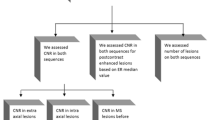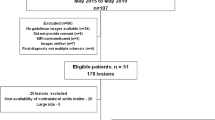Abstract
Objectives
To compare the sensitivity of enhancing multiple sclerosis (MS) lesions in gadolinium-enhanced 2D T1-weighted gradient-echo (GRE) and spin-echo (SE) sequences, and to assess the influence of visual conspicuity and laterality on detection of these lesions.
Methods
One hundred MS patients underwent 3.0T brain MRI including gadolinium-enhanced 2D T1-weighted GRE and SE sequences. The two sets of contrast-enhanced scans were evaluated in random fashion by three experienced readers. Lesion conspicuity was assessed by the image contrast ratio (CR) and contrast-to-noise ratio (CNR). The intracranial region was divided into four quadrants and the impact of lesion location on detection was assessed in each slice.
Results
Six hundred and seven gadolinium-enhancing MS lesions were identified. GRE images were more sensitive for lesion detection (0.828) than SE images (0.767). Lesions showed a higher CR in SE than in GRE images, whereas the CNR was higher in GRE than SE. Most misclassifications occurred in the right posterior quadrant.
Conclusions
The gadolinium-enhanced 2D T1-weighted GRE sequence at 3.0T MRI enables detection of enhancing MS lesions with higher sensitivity and better lesion conspicuity than 2D T1-weighted SE. Hence, we propose the use of gadolinium-enhanced GRE sequences rather than SE sequences for routine scanning of MS patients at 3.0T.
Key Points
• 2D SE and GRE sequences are useful for detecting active MS lesions.
• Which of these sequences is more sensitive at high field remains uncertain.
• GRE sequence showed better sensitivity for detecting active MS lesions than SE.
• We propose GRE sequence for detecting active MS lesions at 3.0T.


Similar content being viewed by others
Abbreviations
- CIS:
-
Clinically isolated syndrome
- CNR:
-
Contrast-to-noise ratio
- CR:
-
Contrast ratio
- EDSS:
-
Kurtzke Expanded Disability Status Scale
- FA:
-
Flip angle
- FN:
-
False negative
- FP:
-
False positive
- GRE:
-
Gradient recalled-echo
- MS:
-
Multiple sclerosis
- SE:
-
Spin-echo
- TP:
-
True positive
References
Filippi M, Rocca M (2011) MR imaging of multiple sclerosis. Radiology 259:659–681
Bakshi R, Thompson AJ, Rocca MA et al (2008) MRI in multiple sclerosis: current status and future prospects. Lancet Neurol 7:615–625
Polman CH, Reingold SC, Banwell B et al (2011) Diagnostic criteria for multiple sclerosis: 2010 revisions to the McDonald criteria. Ann Neurol 69:292–302
Sormani MP, Bruzzi P (2013) MRI lesions as a surrogate for relapses in multiple sclerosis: a meta-analysis of randomised trials. Lancet Neurol 12:669–676
Río J, Castilló J, Rovira A et al (2009) Measures in the first year of therapy predict the response to interferon β in MS. Mult Scler 15:848–853
Rovira A, León A (2008) MR in the diagnosis and monitoring of multiple sclerosis: An overview. Eur J Radiol 67:409–414
Filippi M (2000) Enhanced magnetic resonance imaging in multiple sclerosis. Mult Scler 6:320–326
Runge VM, Patel MC, Baumann SS et al (2006) T1-weighted imaging of the brain at 3 Tesla using a 2-dimensional spoiled gradient echo technique. Invest Radiol 41:68–75
Fischbach F, Bruhn H, Pech M et al (2005) Efficacy of contrast medium use for neuroimaging at 3.0 T: utility of IR-FSE compared to other T1-weighted pulse sequences. J Comput Assist Tomogr 29:499–505
Hodel J, Outteryck O, Ryo E et al (2014) Accuracy of postcontrast 3D turbo spin-echo MR sequence for the detection of enhanced inflammatory lesions in patients with multiple sclerosis. AJNR Am J Neuroradiol 35:519–523
Crombé A, Saranathan M, Ruet A et al (2015) MS Lesions are better detected with 3D T1 gradient-echo than with 2D T1 spin-echo gadolinium-enhanced imaging at 3T. AJNR Am J Neuroradiol 36:501–507
Wertheim AH (2010) Visual conspicuity: a new simple standard, its reliability, validity and applicability. Ergonomics 53:421–442
Kundel HL, Revesz G (1976) Lesion conspicuity, structured noise, and film reader error. AJR Am J Roentgenol 126:1233–1238
Revesz G (1985) Conspicuity and uncertainty in the radiographic detection of lesions. Radiology 154:625–628
Wertheim AH, Hooge ITC, Krikke K, Johnson A (2006) How important is lateral masking in visual search? Exp Brain Res 170:387–402
Lublin FD, Reingold SC, Cohen JA et al (2014) Defining the clinical course of multiple sclerosis. Neurology 83:1–9
Rovira A (2009) Gadolinium-enhanced magnetic resonance imaging in multiple sclerosis. EJHP Pract 15:33–35
Frohman EM, Cutter G, Remington G et al (2010) A randomized, blinded, parallel-group, pilot trial of mycophenolate mofetil (CellCept) compared with interferon beta 1-a (Avonex) in patients with relapsing-remitting multiple sclerosis. Ther Adv Neurol Disord 3:15–28
Gómez-Moreno M, Díaz-Sánchez M, Ramos-González A (2012) Application of the 2010 McDonald criteria for the diagnosis of multiple sclerosis in a Spanish cohort of patients with clinically isolated syndromes. Mult Scler J 18:39–44
Swanton JK, Rovira A, Tintoré M et al (2007) MRI criteria for multiple sclerosis in patients presenting with clinically isolated syndromes: a multicentre retrospective study. Lancet Neurol 6:677–686
Sicotte NL, Voskuhl RR, Bouvier S, Klutch R, Cohen MS, Mazziotta JC (2003) Comparison of multiple sclerosis lesions at 1.5 and 3.0 Tesla. Invest Radiol 38:423–427
Wattjes MP, Lutterbey GG, Harzheim M et al (2006) Higher sensitivity in the detection of inflammatory brain lesions in patients with clinically isolated syndromes suggestive of multiple sclerosis using high field MRI: an intraindividual comparison of 1.5 T with 3.0 T. Eur Radiol 16:2067–2073
Wattjes MP, Harzheim M, Kuhl CK et al (2006) Does high-field MR imaging have an influence on the classification of patients with clinically isolated syndromes according to current diagnostic MR imaging criteria for multiple sclerosis? AJNR Am J Neuroradiol 27:1794–1798
Stehling C, Niederstadt T, Krämer S et al (2005) Comparison of a T1-weighted inversion-recovery-, gradient-echo- and spin-echo sequence for imaging of the brain at 3.0 Tesla. Röfo 177:536–542
Lövblad KO, Anzalone N, Dörfler et al (2010) MR image in multiple sclerosis: Review and recommendations for current practice. AJNR Am J Neuroradiol 31:983–989
Mugler JP 3rd, Brookeman JR (1993) Theoretical analysis of gadopentetate dimeglumine enhancement in T1-weighted imaging of the brain: comparison of two-dimensional spin-echo and three-dimensional gradient-echo sequences. J Magn Reson Imaging 3:761–769
Acknowledgments
The authors thank Celine Cavallo for English language support, and Isidre Rivero and Ignasi Ferrer for their help in post-processing. The scientific guarantor of this publication is Alex Rovira. The authors of this manuscript declare relationships with the following companies: Cristina Auger has received speaking honoraria from Novartis and Genzyme; Paula Alcaide-Leon holds a MS research grant from Novartis; Jaume Sastre-Garriga has received compensation for consulting services and speaking honoraria from Merck-Serono, Biogen-Idec, Teva, Sanofi-Aventis and Novartis; Xavier Montalban has received speaking honoraria and travel expenses for scientific meetings, has been a steering committee member of clinical trials or participated in advisory boards of clinical trials in the past with Bayer Schering Pharma, Biogen Idec, EMD Merck Serono, Genentech, Genzyme, Novartis, Sanofi-Aventis, Teva Pharmaceuticals and Almirall; Alex Rovira serves on scientific advisory boards for Biogen Idec, Novartis, Genzyme, and OLEA Medical, and has received speaker honoraria from Bayer, Genzyme, Sanofi-Aventis, Bracco, Merck-Serono, Teva Pharmaceutical Industries Ltd, OLEA Medical, Stendhal, Novartis and Biogen Idec. The rest of authors of this manuscript declare no relationships with any companies, whose products or services may be related to the subject matter of the article.This study has received funding by Bayer HealthCare Pharmaceuticals. One of the authors has significant statistical expertise. Institutional Review Board approval was obtained. Written informed consent was obtained from all patients in this study. We declare that none of the study subjects or cohorts have been previously reported. Methodology: prospective, observational, performed at one institution.
Author information
Authors and Affiliations
Corresponding author
Rights and permissions
About this article
Cite this article
Aymerich, F.X., Auger, C., Alcaide-Leon, P. et al. Comparison between gadolinium-enhanced 2D T1-weighted gradient-echo and spin-echo sequences in the detection of active multiple sclerosis lesions on 3.0T MRI. Eur Radiol 27, 1361–1368 (2017). https://doi.org/10.1007/s00330-016-4503-3
Received:
Revised:
Accepted:
Published:
Issue Date:
DOI: https://doi.org/10.1007/s00330-016-4503-3




